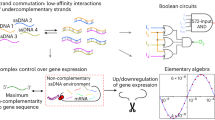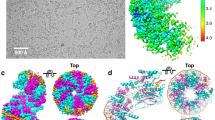Abstract
A NEW species of double-stranded RNA has been detected in certain strains of bakers' yeast, Saccharomyces cerevisiae, during investigations of the chemical nature of the cytoplasmic genetic determinants concerned with the killer character in yeast. There are three phenotypes with respect to this killer phenomenon: killer, sensitive and neutral. Killer cells kill sensitive cells by secreting into the medium a toxic polypeptide1,2 to which they themselves are immune. Neutral cells neither kill nor are killed. The phenomenon is under the control of at least one nuclear gene and two types of cytoplasmic determinant, (k) and (n), which confer the killer and neutral phenotypes respectively3–5.
This is a preview of subscription content, access via your institution
Access options
Subscribe to this journal
Receive 51 print issues and online access
$199.00 per year
only $3.90 per issue
Buy this article
- Purchase on Springer Link
- Instant access to full article PDF
Prices may be subject to local taxes which are calculated during checkout
Similar content being viewed by others
References
Woods, D. R., and Bevan, E. A., J. Gen. Microbiol., 51, 115 (1968).
Bussey, H., Nature New Biology, 235, 73 (1972).
Bevan, E. A., and Somers, J. M., Genet. Res., Camb., 14, 71 (1969).
Somers, J. M., and Bevan, E. A., Genet. Res., Camb., 13, 71 (1969).
Bevan, E. A., Somers, J. M., and Theivendirarajah, K., Proc. Eleventh Intern. Bot. Cong., Seattle (1969).
Berry, E. A., thesis, London University (1971).
Cox, B. S., and Bevan, E. A., New Phytol., 61, 342 (1962).
Kirby, K. S., and Cook, E. A., Biochem. J., 104, 254 (1967).
Ogur, M., and Rosen, G., Arch. Biochem., 25, 262 (1950).
Burton, K., Biochem. J., 62, 315 (1956).
Loening, U. E., Biochem. J., 102, 251 (1967).
Ralph, R. K., Adv. Virus Research, 15, 61 (1969).
Fisher, M., Patricia, and Dingman, C. Wisley, Biochem., 10, 1895 (1971).
Ellis, L. F., and Kleinschmidt, W. J., Nature, 215, 649 (1967).
Banks, G. T., Buck, K. W., Chain, E. B., Darbyshire, J. E., and Himmelweit, F., Nature, 222, 89 (1969).
Banks, G. T., Buck, K. W., Chain, E. B., Darbyshire, J. E., Himmelweit, F., Ratti, G., Sharpe, T. J., and Planterose, D. N., Nature New Biology, 227, 505 (1970).
Lhoas Pol, Nature New Biology, 236, 86 (1972).
Diener, T. O., and Raymer, W. B., Science, 158, 378 (1967).
Semanik, J. S., and Weathers, L. G., Virology, 36, 326 (1968).
Author information
Authors and Affiliations
Rights and permissions
About this article
Cite this article
BERRY, E., BEVAN, E. A New Species of Double-stranded RNA from Yeast. Nature 239, 279–280 (1972). https://doi.org/10.1038/239279a0
Received:
Issue Date:
DOI: https://doi.org/10.1038/239279a0
This article is cited by
-
Anticodon nuclease encoding virus-like elements in yeast
Applied Microbiology and Biotechnology (2012)
-
The killer phenomenon in yeasts
Folia Microbiologica (1986)
-
No evidence for mycoviruses in Entomophthora egressa
Biotechnology Letters (1984)
-
The extrachromosomal control of nonsense suppression in yeast: An analysis of the elimination of [psi +] in the presence of a nuclear gene PNM -
Molecular and General Genetics MGG (1977)
-
The genetic control of DS-RNA virus-like particles associated with Saccharomyces cerevisiae killer yeast
Heredity (1976)
Comments
By submitting a comment you agree to abide by our Terms and Community Guidelines. If you find something abusive or that does not comply with our terms or guidelines please flag it as inappropriate.



